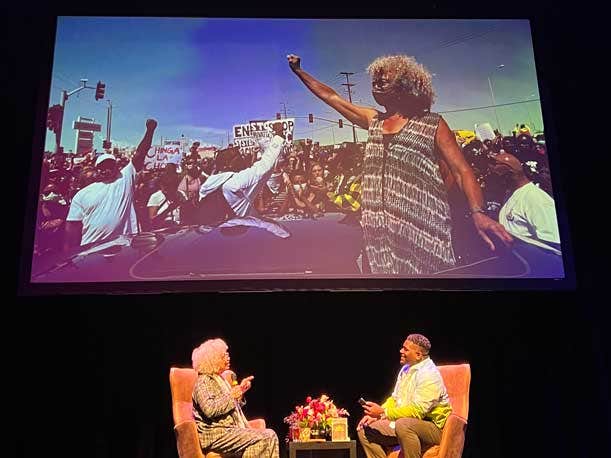What Is Your Why?
CRN columnist Cass Cooper says that understanding the difference between what we do and why we do it is key to organizational and institutional policy change.

Last year I had the privilege of attending a private Q&A session with the incomparable Dr. Angela Y. Davis. For those not familiar, Professor Davis (pictured above left with moderator Jerry L. Hawkins, M.Ed.) is a prominent American political activist, philosopher and scholar who has written extensively on the topics of race, gender and class, and the intersectionality of these issues. Her academic affiliations abound, teaching at UCLA, UC-Santa Cruz, Rutgers University, Syracuse University and Vassar College. She is particularly well-known for her work on liberation, particularly the liberation of marginalized and oppressed groups. Her work extends over five decades. Simply put, she is an OG in American equity and inclusion theory and practice.
Davis’ stance is that true liberation can only be achieved through collective action of marginalized and oppressed groups, and that intersectionality and coalition-building are crucial to this process. She emphasizes that liberation is not only a moral imperative, but also a necessary condition for creating a just and equitable society. But her activism started when she was at odds with law and government. She has been arrested and was wrongfully imprisoned in the early 1970s—even being fired from UCLA for her political affiliations. Her life has been full of death threats, police surveillance, harassment and public ridicule.
So, when Hawkins asked her if she had to go back in time, would she choose the same line of work, her answer was surprisingly simple: ABSOLUTELY, because she knows what motivates her. She knows her true compass in the search for equity and the collective liberation of all who inhabit the earth.
Her response came so quickly and without hesitation. It made me think: What motivates me to be an inclusive leader? What motivates those around me? And are they in alignment with the cultural collective search for justice? Asked more simply, why be a leader who advocates for justice?
What Is Your ‘Why?’
Knowing what motivates us as inclusive leaders provides focus and creates more productive teams that collectively achieve their goals. Understanding the difference between what we do and why we do it is key to organizational and institutional policy change. For Davis, the quest for global liberation and freedom is her “why,” making the risks of activism easier to manage.
In his book "Start with Why: How Great Leaders Inspire Everyone to Take Action," Simon Sinek states that people are motivated by the belief in something greater than themselves. That they are willing to sacrifice their time, energy and effort for something they believe in. Sinek goes on, connecting this to organizational change. Indeed, organizations that can clearly communicate their “why” are more successful in inspiring their employees and customers to act. And within those organizations, it is the leaders who clearly communicate and connect organizational “why” to those they lead—inspiring and motivating toward collective social interest.
Unpacking both the “what” and the “why” is important because it can help us to make more meaningful and fulfilling choices in our business. By focusing on the “why” behind our actions, we can ensure that we are taking actions that align with our values and goals. It moves us beyond a focus on profit and allows space for justice to bubble to the surface.
It is a focus on “why” that helps to identify when our actions are not aligned with our motivations and make changes accordingly.
But how do we arrive at our motivation? I have a personal hack I often use to find the source of conflict or resistance. It has worked in my personal and professional life, keeping me curious about challenges at hand.
It’s simple: I ask why five times. Yes, (at least) five.
Doing so allows us to get to our core belief—to find the underpinnings of motivation. Asking why five times (or more) can help us uncover long-held beliefs about not just ourselves, but the problems we are attempting to solve. Too often we search for solutions rather than taking time to understand the motivations for acting and moving in a specific direction.
Here is where Sinek’s message becomes powerful: People don't follow what you do, they align with why you do it. By focusing on the “why” behind action, inclusive leaders can inspire and motivate themselves, their teams, their organization and their customers to act and achieve remarkable things.
I want to remind you that “what we do” refers to the actions or tasks that we undertake, while “why we do it” refers to the underlying motivation or purpose for those actions. Understanding the difference between the two can help us to make more meaningful and fulfilling choices in our lives and in business, allowing us to move toward eliminating injustice.
In creating organizational change, both Davis and Sinek agree—the collective “why,” built through coalition, is key to making lasting changes and building toward collective goals. In the work of diversity, equity, inclusion and belonging, making changes organizationally are only possible if we build toward and understand the “why” behind the “what.”
I leave you with this question: What are your business’ “whys” for inclusion?
The Inclusive Leadership Newsletter is a must-read for news, tips and strategies focused on advancing successful diversity, equity and inclusion initiatives in technology and across the IT channel. Subscribe today!